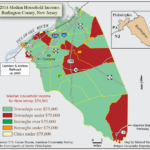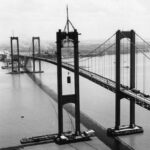Choose a Geography
Bucks County, one of the three original counties of Pennsylvania and the site of William Penn's home, Pennsbury, has its county seat in Doylestown.
Settled primarily by Quakers in the seventeenth century, Burlington County was a great site for commercial and agricultural development. Over time the area diversified in the formation of forty communities spread over 819 square miles.

Formed in 1844 from parts of what had been Gloucester County since 1686, Camden County maintained throughout its history a prominent role in the greater Philadelphia region, sustaining its close association with the city of Philadelphia and serving a central role in the social and economic life of South Jersey. Always a diversified area, the […]
Forming the core of civic, commercial, and residential life since Philadelphia’s seventeenth-century founding, Center City has been a continually evolving experiment in urban living and management.
One of the three original counties of Pennsylvania, Chester County has its seat of government in West Chester, which developed as a borough from its origins as the site of Turk's Head Tavern (1762).
Cumberland County, formed in 1748, over time developed a three-faceted economy of agriculture, maritime activity, and a glass industry.
The borough of Media, incorporated in 1850, is the seat of Delaware County, formed in 1789 from a portion of the original Chester County created when William Penn received his land grant for Pennsylvania.
Strategically located along the Delaware River opposite the southern portion of Philadelphia, Gloucester County played an important role in the region, as a location for waves of settlement, industry and recreation, and even defense during the American Revolution. Formed in 1686 with the intention of establishing townships and jurisdictional courts and named for Gloucestershire, England, […]
Linked to Philadelphia by a shared history of diverse settlement, town-building, industrialization, and suburbanization, South Jersey grew from seventeenth-century settlements by the Dutch, Swedes, and English.
Montgomery County, Pennsylvania
Montgomery County, formed in 1784 from a portion of the original Philadelphia County of William Penn's colony of Pennsylvania, has its county seat in Norristown.
Of the eleven counties in the Philadelphia metropolitan statistical area, New Castle County is perhaps the most varied geographically. Stretching from the Piedmont to the Coastal Plain, it is marked by rolling hills and fast-flowing crystalline streams to the north, sluggish brown tidal creeks meandering towards Delaware Bay to the south. Its northernmost neighborhood at Claymont is virtually an outer suburb of Philadelphia; to the south, the county extends down to the latitude of Baltimore, where Southern culture begins to be detectable. The great majority of the county lies south of the Mason-Dixon Line (drawn between 1763 and 1768). Of all the counties around Philadelphia, it may be the most culturally heterogeneous, for no other touches three states, with distinctive influences flowing in. Southern New Castle County shares the Delmarva Peninsula with Maryland and partly drains into Chesapeake Bay; Wilmington is a stone’s throw across the river from New Jersey; scenic Brandywine Creek knits New Castle County together with Pennsylvania.

North Philadelphia gradually transformed from acres of forests to blocks of homes, factories, churches, universities, and other institutions built to serve the area’s diverse inhabitants.
From its colonial foundations as a farming hinterland to its dramatic post-WWII development, Northeast Philadelphia became a desirable destination for those seeking to improve their economic, social, and cultural standing.
Northwest Philadelphia, as old as the city itself, expanded and changed with the technological, legal, political, and cultural trends of Philadelphia.
Before Philadelphia’s founding, Salem, New Jersey, was the first English Quaker colony along the Delaware River.
With an array of ethnic, racial, and religious groups, South Philadelphia is an urban village with a history of immigration and working-class striving.
The first section of Philadelphia settled by Europeans came to national attention in the twentieth century as the Eastwick Urban Redevelopment Project. With the Philadelphia International Airport straddling this vicinity and adjacent Delaware County, Southwest Philadelphia also links the region to the world.
Reaching from the Schuylkill River to the western city line, West Philadelphia developed as a distant suburb of Philadelphia between 1720 and 1840.